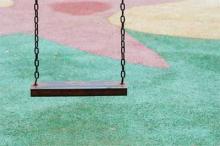
In the context of playgrounds, “shock absorbing” refers to the properties of the protective surface that assist in preventing or minimizing injuries. Shock absorbing is also referred to as “impact attenuating” as it relates to playground surfacing. The specification for impact attenuation is directed to the reduction of risk for head injuries.1 Head injuries are the most serious fall-related injuries and are the ones most often associated with playground deaths. However, having a shock absorbing surface can reduce the severity of other fall-related injuries as well.2
Surface impact testing is done in the laboratory and in the field with an instrument called the Triax 2000. This uses an instrumented head form that resembles the size and shape of a child’s head. This missile is dropped from various heights onto the protective surface in order to ascertain the surface critical fall height which is the “…maximum fall height from which a life-threatening head injury would not be expected to occur.”3
To meet the specification for shock absorbing properties, a g-max score must not exceed 200 and an HIC score must not exceed 1000.4 The g-max refers to the maximum acceleration of the test missile and measures the force of the impact. The HIC score is a mathematical formula that measures the duration of the impact.
The basis of the playground head injury test data comes from automotive and aircraft impact protection research. Up until recently, there has been no research directly relating to playground fall injuries, so the data from aircraft and auto impact injuries has been related to the severity of injuries on playgrounds.5
Playground surfacing specifications are currently under review with the goal of lowering the impact values to reduce both head injuries and fractures.
There are different types of playground surface materials that are shock absorbing. The most common types are engineered wood fiber, poured-in-place rubber, rubber mats, shredded rubber, and artificial turf. Wood chips, sand, and pea stone are also considered shock absorbing but are no longer appropriate to use on playgrounds because they are not accessible in compliance with the Americans with Disabilities Act.
All manufacturers of surfacing material must be able to provide test data to show that the shock absorbing or impact attenuating properties of their surfacing are appropriate for the fall height of the playground where the surfacing will be used.
- 1. ASTM International (ASTM) standard F1292-13, “Standard Specification for Impact Attenuation of Surfacing Materials Within the Use Zone of Playground Equipment,” 1.9, p. 2.
- 2. Ibid., ASTM F 1292-13, Introduction, p. 1.
- 3. Ibid., ASTM F 1292-13, 3.1.1, p. 2.
- 4. Ibid., ASTM F 1292-13, 4.2, p. 4.
- 5. Ibid., ASTM F 1292-13, X1.1, p. 17.

